Leaves
Organization of Tissues into Tissue Systems
| The tissues of the leaves, as with the other organs, are organized into three tissue systems: dermal, vascular, and ground tissue systems. To the right is a diagram of a Young Plant, illustrating a cross-section through a leaf. |
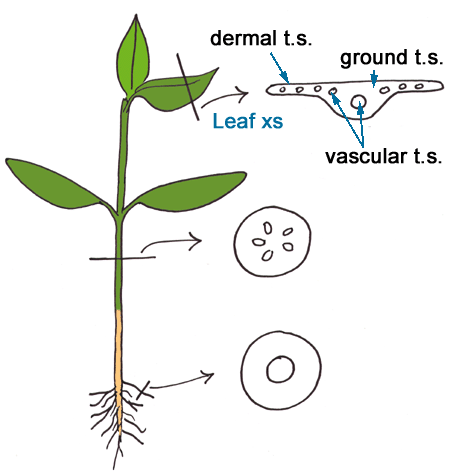 Diagram of a Young Plant, Cross Section Through a Leaf |
(i) Dermal Tissue System
The dermal tissue system is the outer layer of the leaf. It is generally one cell layer thick. The leaf is produced during primary growth and does not undergo secondary growth. The epidermis therefore is the dermal layer of theleaf throughout its lifespan.
(ii) Vascular Tissue System
As in the other organs, the vascular tissue system is made up of two types of tissues: xylem and phloem. In most plants the main function of the leaves is photosynthesis. It is therefore very important that there be a very extensive network of vascular tissues taking the carbohydrates away from the site of synthesis to those parts that need it as well as to get water and nutrients up into the leaves..
(iii) Ground Tissue System
Photosynthetic parenchyma tissue is the most important component of the ground tissue system in the leaf. This parenchyma tissue is often given the name of mesophyll.
| In most cases leaves serve as the main photosynthetic organ of a plant. Dr. Nancy Turner (below) is demonstrating the large leaf of a skunk cabbage (also known as the swamp lantern). Although generally not eaten it served as “wax paper” by First Peoples wherever it grew. |
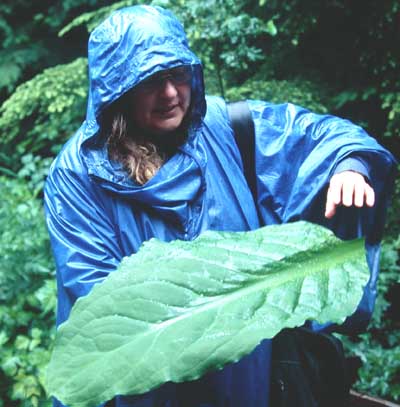 Large leaf of Skunk Cabbage (Lysichiton americana) |
| Much of the leaf is photosynthetic tissue. A network of vascular tissue is also very important. Photosynthates must be carried from the leaf while water and nutrients into the leaf. The young tomato leaf below has been cleared (colour removed) and then stained to reveal the veins. This leaf has reticulate or netted venation (netlike network of veins). |
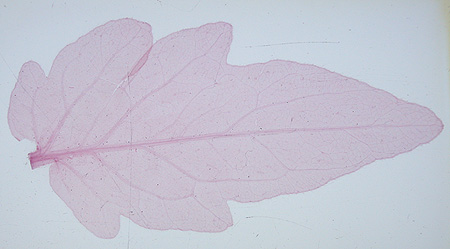 Prepared Slide of Cleared Tomato Leaf |
| The intricate pattern of the ensures that a mesophyll cell is not more than a few cells away from vascular tissue. This can be seen in the cross section of the leaf to the right. |
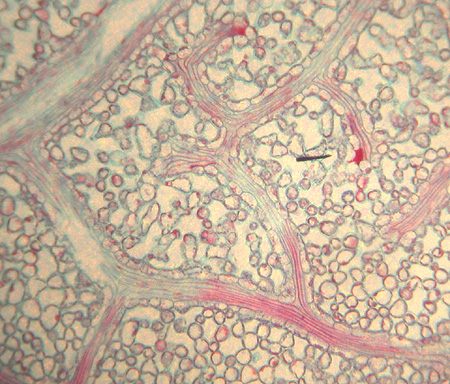 A Close look at the Venation in a Leaf |
| Lonicera has simple leaves.The leaves are elliptical, as you can see in the photo to the right. |
 Branch of Lonicera |
| The cross-section through a leaf stained with toluidine blue is pictured below. The ground tissue is primarily made up of two types of parenchyma cells: palisade mesophyll and spongy mesophyll. These are the photosynthetic cells of the leaves. |
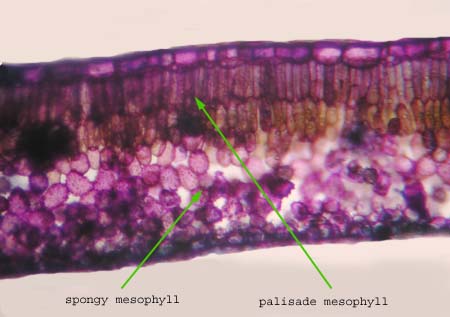 Cross Section Through a Leaf |
| Most monocots have parallel venation. This means that the main veins run in parallel.In most monocots you do not have a distinction between the palisade and the spongy mesophyll. |
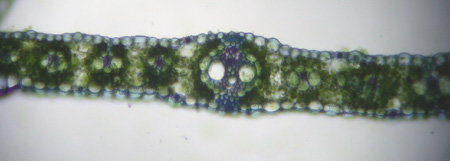 Cross Section Through a Corn Leaf |
| You can still determine the top and bottom of such leaves by the orientation of the vascular tissues. In the cross-section to the right, the leaf is actually upside down. Phloem faces toward the lower side of the leaf. Why would this be so? |
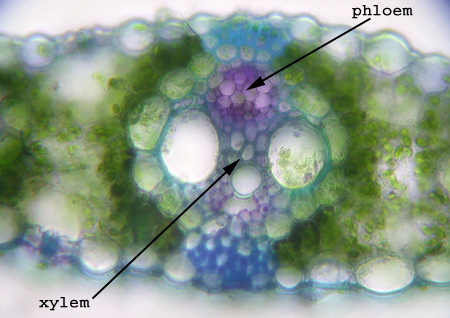 Vascular Bundle in the Leaf of Corn |
| Leaves can be modified in various ways to accommodate their survival in particular habitats. Peperonia, which is a common houseplant grows in areas that have drought periods. |
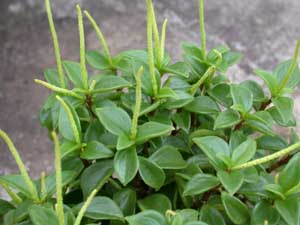 Peperomia Plant |
| The leaves retain water in the multilayered upper epidermis. As you can see in the cross-section to the right, the Peperomia leaf has two distinct regions. The clear tissue is a multilayered epidermis. |
 Cross Section Through the Leaf of Peperomia |
| Aloe vera is another common houseplant that stores water in its leaves. Aloe is commonly used to sooth burns and abrasions of the skin. The cells of the central part of the leaf is made up of parenchyma which contain not only water, but also mucilages and other chemicals. |
 Aloe Leaf Cut From Plant |
| This cross-section of a leaf shows the ground tissue is made up of photosynthetic cells to the outside and the storage parenchyma cells to the inside. |
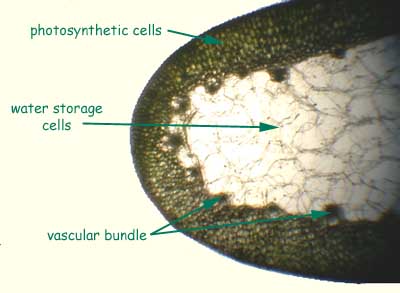 Cross Section Through Aloe Leaf |
| In some cases the leaves do not perform photosynthesis, but serve as protection for the green photosynthetic tissue of the stem. This is a common characteristic of members of the Cactus family. The green pads of this nopale cactus (Opuntia) are stem while the sharp projections are modified leaves (spines). |
 Nopale Cactus, a Common Food in Central America |
| Plants that live in ecosystems low in nutrients often have modifications that help them survive.The Drosera (sundew) grows in peatlands. To get nitrogenous compounds it actually traps and digests insects. |
 Sundew Amongst Cranberry and Blueberry Plants |
| The leaves have hairs that end in glistening drops of mucilage which look appetizing to insects. An unlucky insect gets stuck to the end of the hair and digestive enzymes are secreted and nutrients absorbed and transported to other parts of the plants |
 A Sundew Plant |
| Many leaves are modified to aid in the asexual reproduction of the plant. In Kalenchoe (mother of thousands) small plantlets are produced around the margin of the leaf. |
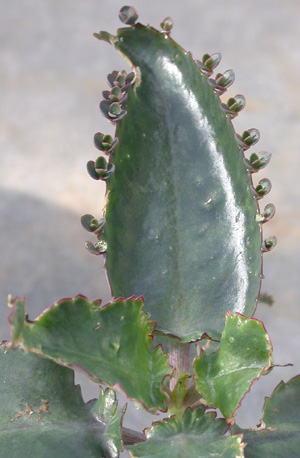 Plantlets Borne from Edge of Leaf |
| When a plantlet falls to the ground it produces roots and becomes a clone of the mother plant. |
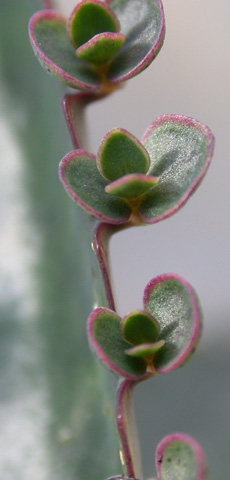 |

















